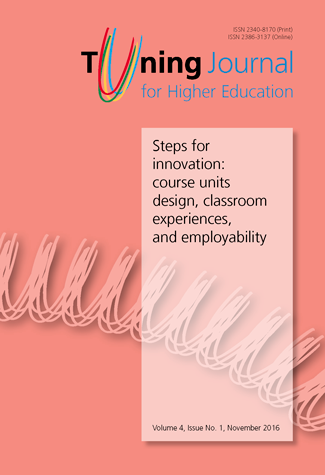Improving Basic Design courses through Competences of Tuning MEDA
Abstract
It is well established that Tuning’s development of the concept of competences for the improvement of what is referred to as student-centered approach has proven itself beneficial in developing higher education programs.[1] This paper examines the application of competences suggested by Tuning-MEDA to the benefit of teaching architecture. Two courses were selected from the Architectural Engineering Program at the International University for Science and Technology, Damascus, Syria; namely, Basic Design I and II. Five competences were selected as crucial to be achieved in these two courses: ability to think, perceive and conceive spaces three dimensionally and communicate verbally, in writing, graphically, and/or volumetrically; have critical thinking, analysis and synthesis; knowledge of aesthetics and arts, and understanding their role as key factors in the quality of architectural thinking and design; possess a high level of interpersonal skills; and appreciation of the social and cultural role of architecture. The two courses are evaluated at two levels before being examined in relation to their ability to achieve these competences. They were looked at in connection with Bloom’s Taxonomy and found to be able to deliver learning at its upper levels; namely, analysis, synthesis, and evaluation. They were also examined against the typical Learning Retention Pyramid and were found to provide learning opportunities through learning techniques which provide a high level of retention: demonstration, group discussion, and practice by doing. Finally, it was found that the five competences assigned to the courses were very much achievable and indeed through applying them, the two courses were more focused and could achieve their objectives more successfully.
Published online: 30 November 2016
[1] Robert Wagenaar, “Competences and learning Outcomes: a Panacea for Understanding the (New) Role of Higher Education?” Tuning Journal for Higher Education 1, no. 2 (May 2014): 279-302.
Downloads
References
Augusti, Giuliano. “Transnational Recognition and Accreditation of Engineering Educational Programmes in Europe: Perspectives in a Global Framework.” European Journal of Engineering Education 31, no. 3 (2006): 249-260.
Baker, Thomas, and Howard Smith Jr. “Integrating Accreditation into Strategic Planning.” Community College Journal of Research and Practice 60, no. 3 (February 2007): 21-27.
Bedny, Alexander, Liliya Erushkina, and Oleg Kuzendov. “Modernising Education Programmes in ICT Based on the Tuning Methodology.” Tuning Journal for Higher Education 1, no. 2 (May 2014): 387-404.
Beneitone, Pablo, and Edurne Bartolomé. “Global Generic Competences with Local Ownership: a Comparative Study from the Perspective of graduates in Four World Regions.” Tuning Journal for Higher Education 1, no. 2 (May 2014): 303-334.
Cerqueira, Marcos., A Literature Review on the Benefits, Challenges and Trends in Accreditation as a Quality Assurance System, p. 7.
Gelernter, Mark. “Reconciling Lectures and Studios.” Journal of Architectural Education 41, no. 2 (1988): 46.
Girot, Elizabeth. “Assessment of Competence in Clinical Practice — A Review of the Literature.” Nurse Education Today 13, no. 2 (April 1993): 83-90.
Gonzalez, Julia, and Maria Yarosh, “Building Degree Profiles. The Tuning Approach,” Tuning Journal for Higher Education 1, no. 1, (Nov. 2013): 37-69.
Groat, Linda, and Sherry B. Ahrentzen. “Voices for Change in Architectural Education: Seven Facets of Transformation from the Perspectives of Faculty Women.” Journal of Architectural Education 50, no. 4 (1997): 271-285.
Hahn, Karola, and Damtew Teferra. “Tuning as Instrument of Systematic Higher Education reform and Quality Enhancement: The African Experience.” Tuning Journal for Higher Education 1, no. 1 (November 2013): 127-163.
http://thesecondprinciple.com/teaching-essentials/beyond-bloom-cognitivetaxonomy-revised/ (Retrieved 10/4/2016).
http://www.westmuse.org/sites/westmuse.org/files/uploads/2012/03/pyramid.png (Retrieved 16/4/2016).
Mazumdar, Sanjoy. “Cultural Values in Architectural Education: An Example from India.” Journal of Architectural Education 46, no. 4, (1993): 230-238.
Nicklin, Wendy, The Value and Impact of Health Care Accreditation. Accreditation Canada, 2008, pp. 2-4.
Patil, Arun, and Gary Codner. “Accreditation of Engineering Education: Review, Observations and Proposal for Global Accreditation.” European Journal of Engineering Education 32, no. 6 (2007): 639-651.
Serbati, Anna, and Alessio Surian. “Developing Reflection on Competence-Based Learning: the Russian Experience with the Tuning Approach.” Tuning Journal for Higher Education 1, no. 2 (May 2014): 463-481.
Sid Nair, Chenicheri, Arun Patil, Patricie Metrova. “Re-engineering graduate skills — a case study.” European Journal of Engineering Education 34, no. 2 (2009): 131-139.
Tuning for the Middle East and North Africa: Architecture. Fourth Report, University of Deusto, 16, 3, 2016.
Wagenaar, Robert. “Columbus Egg? Qualifications Frameworks, Sectoral Profiles and Degree Programme Profiles in Higher Education,” Tuning Journal for Higher Education 1, no. 1 (November 2013): 71-103.
_____. “Competences and learning Outcomes: a Panacea for Understanding the (New) Role of Higher Education?” Tuning Journal for Higher Education 1, no. 2 (May 2014): 279-302.
Authors are required to sign and submit a copyright transfer agreement after acceptance but before publication of their manuscript. To that effect, they receive, from the Managing Editor of Tuning Journal for Higher Education, a standard copyright assignment form designed along the following lines:
1. Authorship:
The author who signs the copyright transfer agreement must be the sole creator of the work or legally acting on behalf of and with the full agreement of all the contributing authors.
2. Copyright and Code of conduct:
a) Authors warrant that their work is original; has not been previously copyrighted or published in any form; is not under consideration for publication elsewhere; its submission and publication do not violate TJHE Ethical Guidelines for Publication and any codes (of conduct), privacy and confidentiality agreements, laws or any rights of any third party; and no publication payment by the Publisher (University of Deusto) is required.
b) Authors are solely liable for the consequences that may arise from third parties’ complaints about the submitted manuscript and its publication in Tuning Journal for Higher Education (TJHE).
c) Authors grant to the Publisher the worldwide, sub-licensable, and royalty-free right to exploit the work in all forms and media of expression, now known or developed in the future, for educational and scholarly purposes.
d) Authors retain the right to archive, present, display, distribute, develop, and republish their work (publisher's version) to progress their scientific career provided the original publication source (Tuning Journal) is acknowledged properly and in a way that does not suggest the Publisher endorses them or their use of the wortk.
e) Authors warrant that no permissions or licences of any kind will be granted that might infringe the rights granted to the Publisher.
3. Users:
Tuning Journal for Higher Education is an Open Access publication. Its content is free for full and immediate access, reading, search, download, distribution and reuse in any medium or format only for non-commercial purposes and in compliance with any applicable copyright legislation, without prior permission from the Publisher or the author(s). In any case, proper acknowledgement of the original publication source must be made and any changes to the original work must be indicated clearly and in a manner that does not suggest the author’s and or Publisher’s endorsement whatsoever. Any other use of its content in any medium or format, now known or developed in the future, requires prior written permission of the copyright holder.


1.jpg)
1.jpg)
.jpg)
1.jpg)
.jpg)
.jpg)









